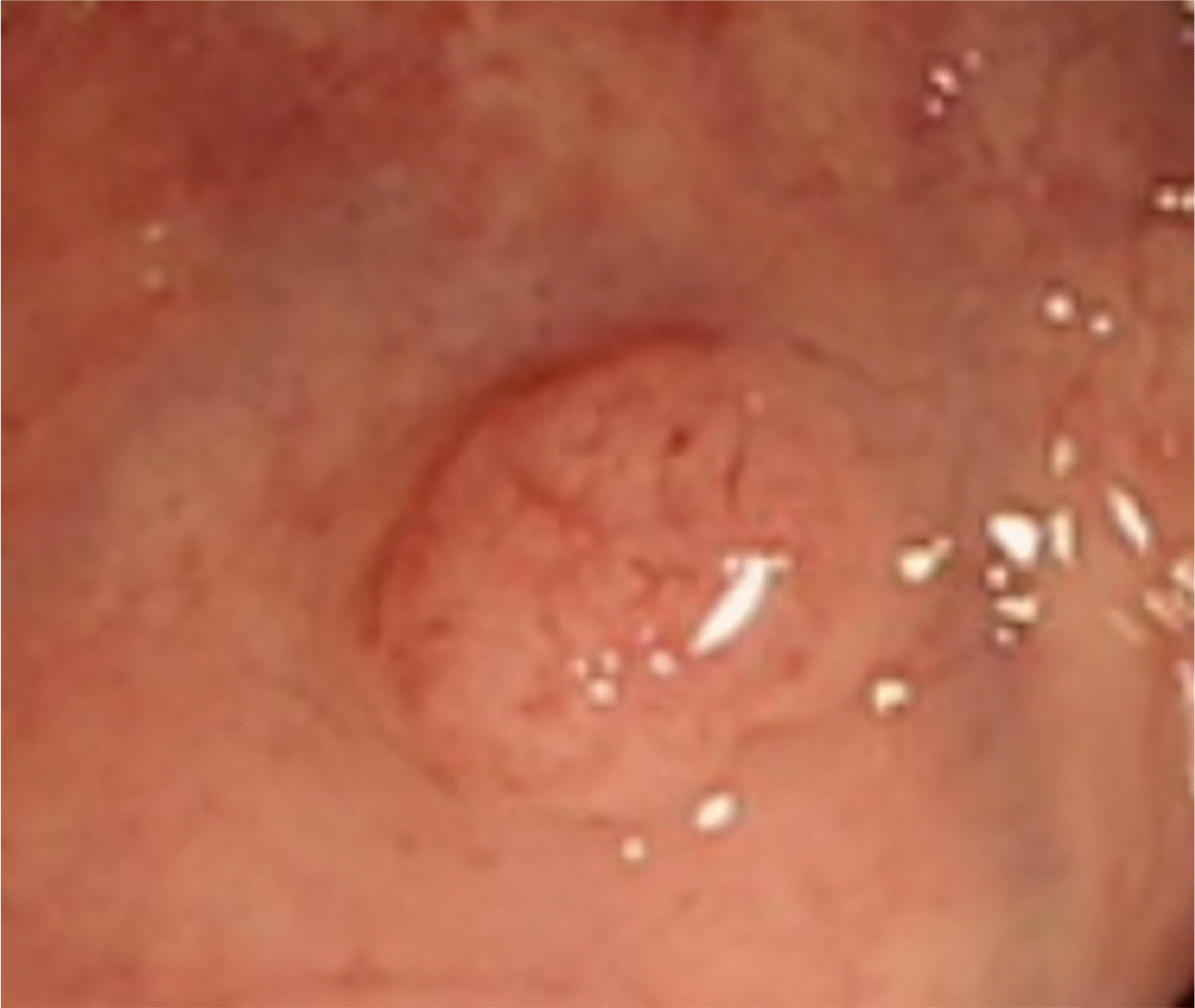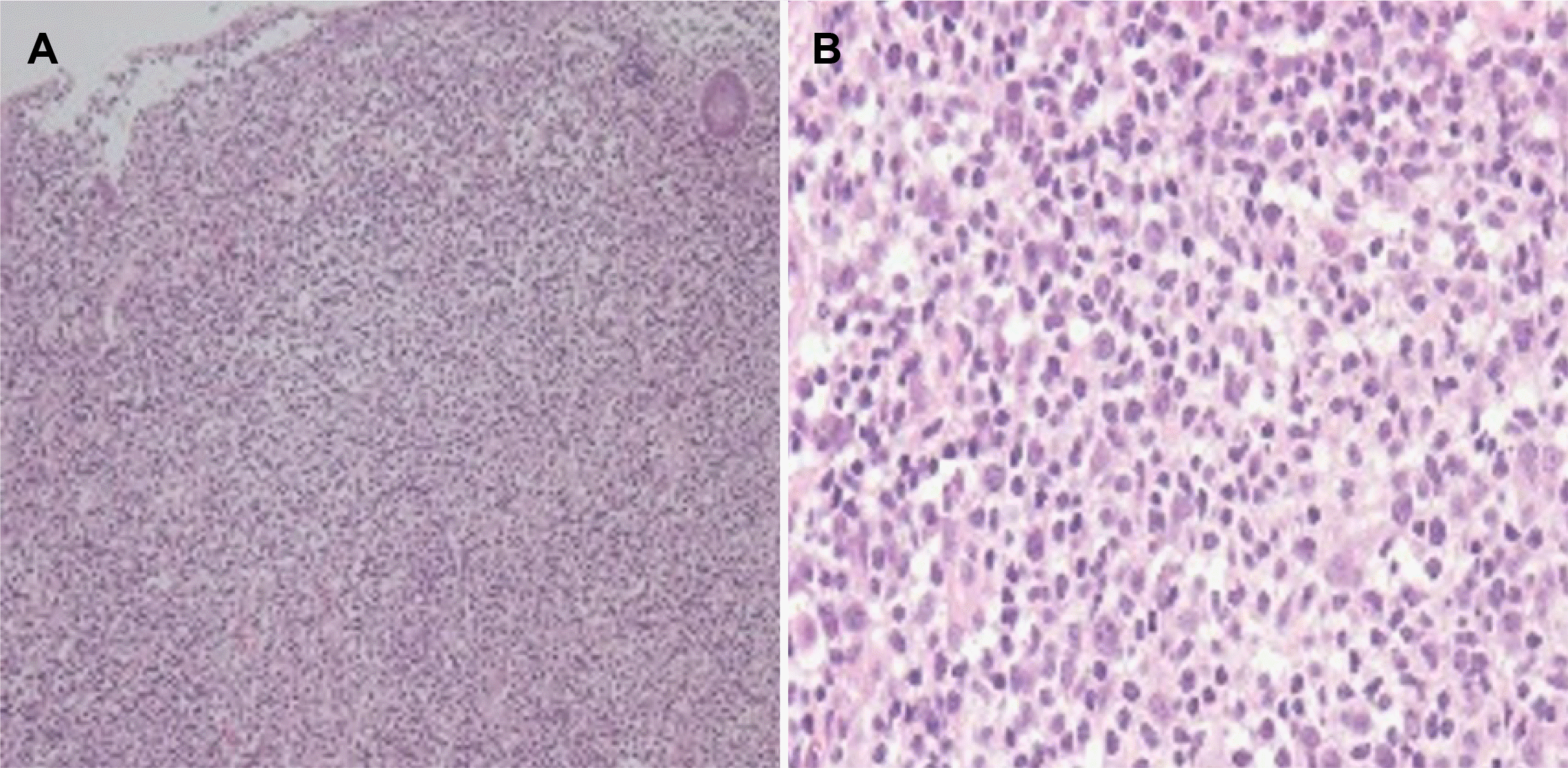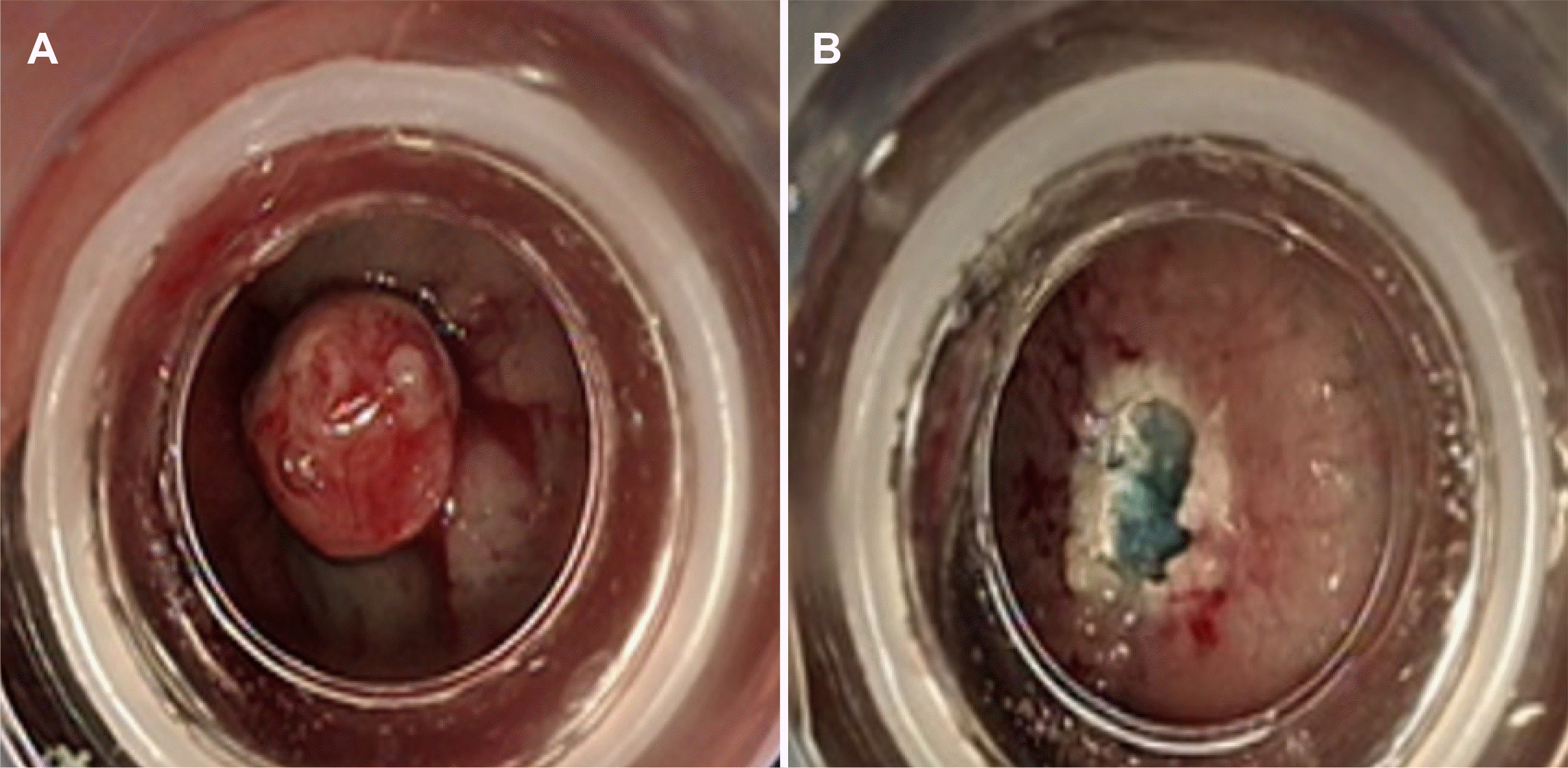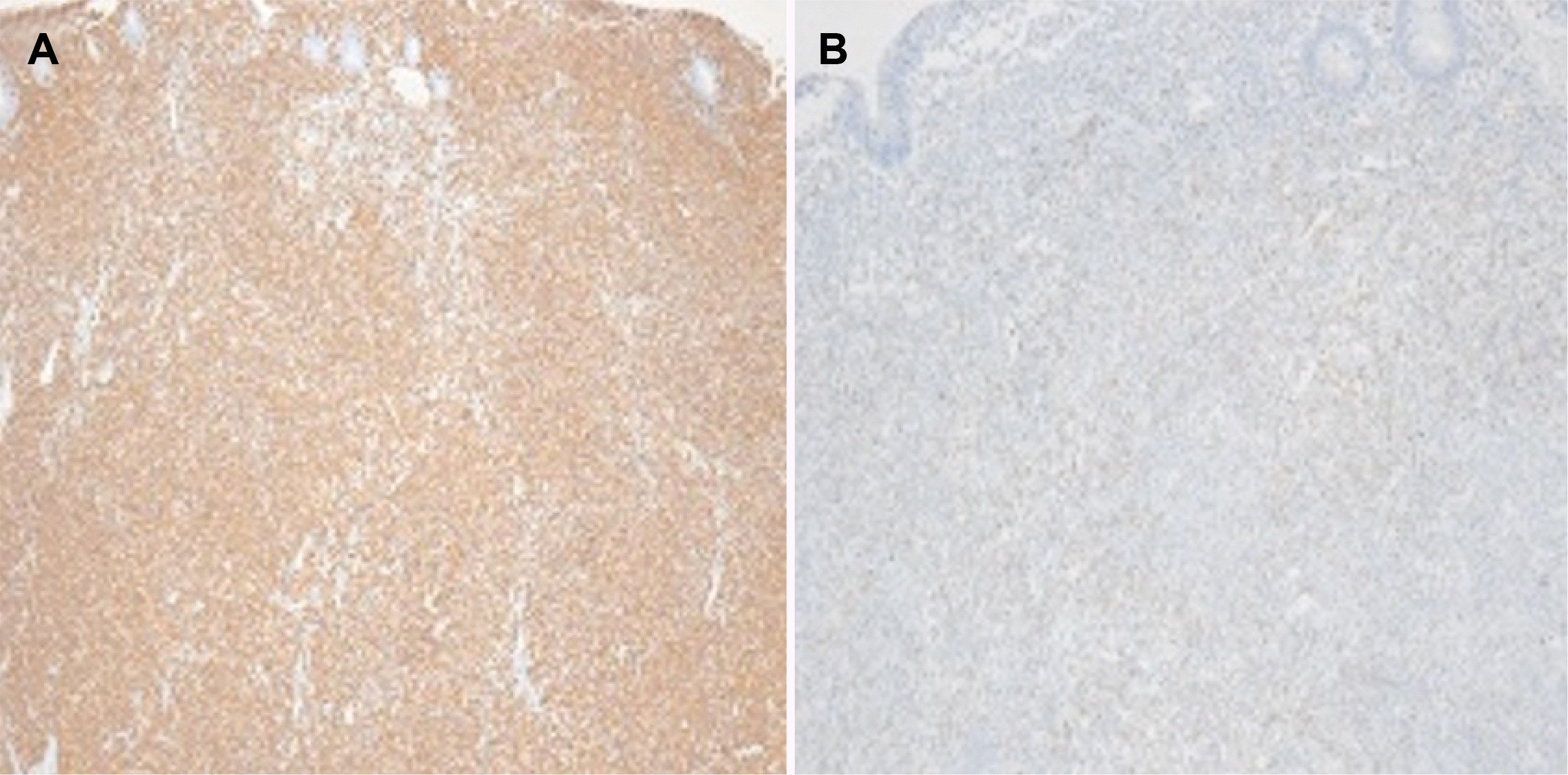1. Stanojevic GZ, Nestorovic MD, Brankovic BR, Stojanovic MP, Jovanovic MM, Radojkovic MD. 2011; Primary colorectal lymphoma: An overview. World J Gastrointest Oncol. 3:14–18. DOI:
10.4251/wjgo.v3.i1.14. PMID:
21267399. PMCID:
PMC3026053.

2. Howell JM, Auer-Grzesiak I, Zhang J, Andrews CN, Stewart D, Urbanski SJ. 2012; Increasing incidence rates, distribution and histological characteristics of primary gastrointestinal non-Hodgkin lymphoma in a North American population. Can J Gastroenterol. 26:452–456. DOI:
10.1155/2012/480160. PMID:
22803021. PMCID:
PMC3395447.

3. Jeon MK, So H, Huh J, et al. 2018; Endoscopic features and clinical outcomes of colorectal mucosa-associated lymphoid tissue lymphoma. Gastrointest Endosc. 87:529–539. DOI:
10.1016/j.gie.2017.08.027. PMID:
28882576.

5. Alkan S, Karcher DS, Newman MA, Cohen P. 1996; Regression of salivary gland MALT lymphoma after treatment for Helicobacter pylori. Lancet. 348:268–269. DOI:
10.1016/S0140-6736(05)65578-X. PMID:
8684218.

6. Choi SM, Jung HY, Kang GH, et al. 2001; Early histologic response to eradication therapy in low-grade gastric mucosa-associated lymphoid tissue lymphoma according to polymerase chain reaction-based B-cell monoclonality. Korean J Gastroenterol. 37:247–253.
7. Wotherspoon AC, Doglioni C, Diss TC, et al. 1993; Regression of primary low-grade B-cell gastric lymphoma of mucosa-associated lymphoid tissue type after eradication of Helicobacter pylori. Lancet. 342:575–577. DOI:
10.1016/0140-6736(93)91409-F. PMID:
8102719.

8. Grünberger B, Wöhrer S, Streubel B, et al. 2006; Antibiotic treatment is not effective in patients infected with Helicobacter pylori suffering from extragastric MALT lymphoma. J Clin Oncol. 24:1370–1375. DOI:
10.1200/JCO.2005.02.9025. PMID:
16549831.

9. Shepherd NA, Hall PA, Coates PJ, Levison DA. 1988; Primary malignant lymphoma of the colon and rectum. A histopathological and immunohistochemical analysis of 45 cases with clinicopathological correlations. Histopathology. 12:235–252. DOI:
10.1111/j.1365-2559.1988.tb01939.x. PMID:
3366441.

10. Jinnai D, Iwasa Z, Watanuki T. 1983; Malignant lymphoma of the large intestine--operative results in Japan. Jpn J Surg. 13:331–336. DOI:
10.1007/BF02469515. PMID:
6645123.
11. Ahlawat S, Kanber Y, Charabaty-Pishvaian A, et al. 2006; Primary mucosa-associated lymphoid tissue (MALT) lymphoma occurring in the rectum: a case report and review of the literature. South Med J. 99:1378–1384. DOI:
10.1097/01.smj.0000215855.98512.9d. PMID:
17233195.

12. Kim JH, Moon YS, Lee SH, et al. 2008; A case of primary B cell mucosa-associated lymphoid tissue lymphoma presenting as a solitary rectal mass. Korean J Gastrointest Endosc. 36:102–106.
13. Park H, Chung JW, Kim AJ, et al. 2012; A case of rectal mucosa-associated lymphoid tissue lymphoma diagnosed by endoscopic unroofing technique. Korean J Gastroenterol. 59:428–432. DOI:
10.4166/kjg.2012.59.6.428. PMID:
22735876.

14. Matsuo S, Mizuta Y, Hayashi T, et al. 2006; Mucosa-associated lymphoid tissue lymphoma of the transverse colon: a case report. World J Gastroenterol. 12:5573–5576. DOI:
10.3748/wjg.v12.i34.5573. PMID:
17007004. PMCID:
PMC4088249.

15. Nakase H, Okazaki K, Ohana M, et al. 2002; The possible involvement of micro-organisms other than Helicobacter pylori in the development of rectal MALT lymphoma in H. pylori-negative patients. Endoscopy. 34:343–346. DOI:
10.1055/s-2002-23643. PMID:
11932795.

16. Inoue F, Chiba T. 1999; Regression of MALT lymphoma of the rectum after anti-H. pylori therapy in a patient negative for H. pylori. Gastroenterology. 117:514–515. DOI:
10.1053/gast.1999.0029900514b. PMID:
10465640.

17. Matsumoto T, Iida M, Shimizu M. 1997; Regression of mucosa-associated lymphoid-tissue lymphoma of rectum after eradication of Helicobacter pylori. Lancet. 350:115–116. DOI:
10.1016/S0140-6736(05)61818-1. PMID:
9228971.

18. Li B, Shi YK, He XH, et al. 2008; Primary non-Hodgkin lymphomas in the small and large intestine: clinicopathological characteristics and management of 40 patients. Int J Hematol. 87:375–381. DOI:
10.1007/s12185-008-0068-5. PMID:
18409078.

19. Kobayashi T, Takahashi N, Hagiwara Y, et al. 2008; Successful radiotherapy in a patient with primary rectal mucosa-associated lymphoid tissue lymphoma without the API2-MALT1 fusion gene: a case report and review of the literature. Leuk Res. 32:173–175. DOI:
10.1016/j.leukres.2007.04.017. PMID:
17570523.

20. Mathew A, Humburg BC, Bayer MG. 2009; A case of rectal MALT lymphoma treated by endoscopic resection. Am J Gastroenterol. 104:255–256. DOI:
10.1038/ajg.2008.47. PMID:
19098890.

21. Shah RM, Kuo V, Schwartz A. 2020; Endoscopic mucosal resection and cure for rectal mucosa-associated lymphoid tissue lymphoma. Proc (Bayl Univ Med Cent). 34:305–306. DOI:
10.1080/08998280.2020.1836939. PMID:
33678972. PMCID:
PMC7901432.

22. Wei YL, Min CC, Ren LL, et al. 2021; Laterally spreading tumor-like primary rectal mucosa-associated lymphoid tissue lymphoma: a case report. World J Clin Cases. 9:3988–3995. DOI:
10.12998/wjcc.v9.i16.3988. PMID:
34141757. PMCID:
PMC8180215.

23. Lim HK, Lee SJ, Baek DH, et al. Resectability of rectal neuroendocrine tumors using endoscopic mucosal resection with a ligation band device and endoscopic submucosal dissection. Gastroenterol Res Pract. 2019; Sep. 16. [Epub ahead of print]. DOI:
10.1155/2019/8425157. PMID:
31687016. PMCID:
PMC6811798.

24. Lee J, Park YE, Choi JH, et al. 2020; Comparison between cap-assisted and ligation-assisted endoscopic mucosal resection for rectal neuroendocrine tumors. Ann Gastroenterol. 33:385–390. DOI:
10.20524/aog.2020.0485. PMID:
32624659. PMCID:
PMC7315720.







 PDF
PDF Citation
Citation Print
Print





 XML Download
XML Download